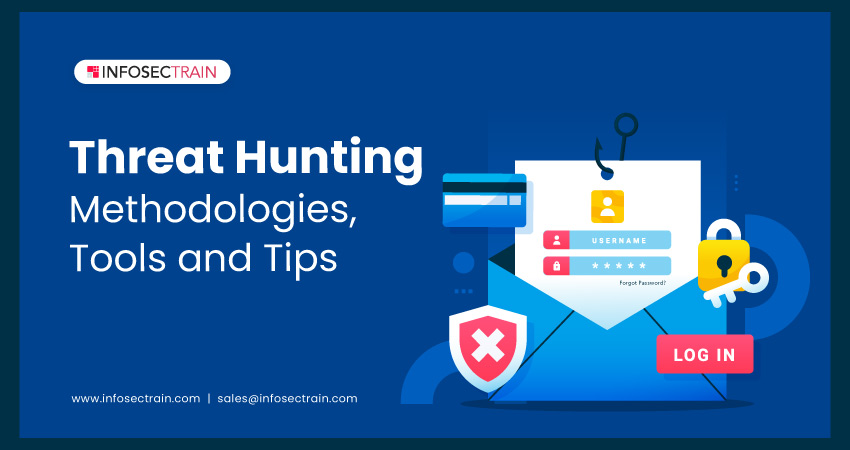Threat Hunting: Methodologies, Tools and Tips
Threat Hunting is a proactive method used by Security Analysts for identifying unfamiliar or non-remediate cyber threats in the organization’s network. It includes searching iterative methods to identify indicators of compromise, threats such as Advanced Persistent Threats (APTs), and Hacker tactics, techniques, and procedures (TTP), which damage the existing system.

A threat hunting program is based on data analysis, in which an organization has an enterprise security system that collects a huge amount of data. The information collected from it includes confidential clues for Threat Hunters. The art of threat hunting goes beyond the traditional detection approach, such as Security information and event management (SIEM), Endpoint detection and response (EDR), and others. They search for hidden attackers and look for patterns of suspicious activities. To prevent any other cyberattacks from recurring, they patch an enterprise’s security system.
Threat Hunting Methodologies
The following are the most commonly used threat hunting methodologies:
1. Intelligence-based hunting
Intelligence-based hunting is an active hunting approach that reacts to intelligence input sources. Intelligence such as IP addresses, indicators of compromise, domain names, and hash values are used.
The Structured Threat Information Expression (STIX) and Trusted Automated Exchange of Intelligence Information (TAXII) are used to enter the data into your SIEM.
This approach is combined with SIEM and threat intelligence tools, which employ intelligence to find cyber threats. Another excellent intelligence source is the host or network artifacts offered by Computer Emergency Response Teams (CERTs), which allow you to export automatic warnings.
2. Investigation using indicators of attack
Investigation using indicators of attack is the most proactive threat hunting method, which is to identify the APT groups and attacks using global detection playbooks. It is a frequently used method with threat frameworks like MITRE ATT&CK.
The following are the actions involved in this method:
- Using TTP and IOAs to identify threat actors
- After identifying, the Threat Hunter attempts to locate patterns by monitoring activities. It helps to isolate the threat by locating and identifying the patterns.
- To build a hypothesis that aligns with MITRE, the hunter evaluates the environment, domain, and attack behaviors.
3. Hypotheses-based hunting
The Hypotheses threat hunting involves three types:
- Analytics-driven: The analytics-driven hypotheses are developed based on the existing structured frameworks, models, and information collected from machine learning and artificial intelligence.
- Situational-awareness: It uses existing information and situational awareness about the environment to identify the potential threats to target.
- Intelligence-driven: An intelligence-driven hypothesis is developed based on threat actor “tactics, techniques, and procedures” (TTP). The hunters test this hypothesis by observing and inspecting the systems and network to check whether the TTP behaviors are present in the environment. ‘Indicators of compromise’ (IoCs) or ‘indicators of attack(IoAs) can support intelligence-based hypotheses.
4. Hybrid hunting
Security Analysts can customize the hunt using the hybrid threat hunting strategy, including all previous methodologies. It generally combines industry-based hunting with situational awareness and specific hunting requirements. For example, data on geopolitical situations are used to customize the hunt.
Due to the massive quantity of data acquired, Threat Hunters must use machine learning techniques and threat intelligence to automate a substantial part of the procedure.
Threat Hunting Tools
To identify suspicious behaviors, Threat Hunters employ solutions and technologies. The following are the primary categories of threat hunting tools:
- Network security monitoring tools: Antivirus, firewalls, and endpoint security solutions collect and monitor network security data.
- SIEM solutions: Security information and event management (SIEM) solutions assist in handling raw security data and real-time threat analysis.
- Analytics tools: Statistical and intelligence analysis software generates a visual report using interactive graphs and charts, making it easier to connect dots and spot patterns.
Threat Hunting Tips
Every year, data breaches and cyberattacks cost organizations millions of dollars. These tips might assist in detecting threats more effectively:
1. Identify specific attributes
When a threat is found, investigate its properties and seek attributes, such as a unique URL. The more specific features can be identified by sorting and filtering the dataset. The red team or penetration testing team can assist in creating forensic artifacts that are used to specify such attributes.
2. Scope your data
SIEM, data logs, and network logs are excellent sources of threat hunting, but the parameters over data volume will sift.
3. Use of sorting techniques
Sorting is required to reduce the data collection size and focus on potential threats. Sort the data set from smaller to larger bytes and focus on the large files. It incorporates visualization to identify communication pattern abnormalities that require further investigation.
4. Look for tunneled communications
Indications of command and control are an excellent source of adversary activity. It tries to imitate regular traffic, such as tunneled communications, which use one network protocol to transport another. Because many corporate firewalls allow outbound DNS traffic, threat actors will embed their messages in DNS traffic.
5. Look for service oddities
Service oddities are network abnormalities, such as when a port or protocol is used unexpectedly or unusually. For instance, Port 443 is used for SSL/TLS traffic. Hence, if HTTP traffic on Port 443 is not on that port, it is a service oddity.
Skills required to become a Threat Hunter
A Security Analyst as a Threat Hunter identifies, isolates, and counteracts APTs that are not discovered by automated security technologies using human or machine-assisted methodologies. Threat hunting training and certification help to enhance their abilities.
The essential skills required to become a Threat Hunter are as follows:
- Data analytics and reporting skills.
- Good knowledge of operating networks and systems.
- Good knowledge and understanding of threat hunting methods and TTP used by the attackers.
Threat Hunting with InfosecTrain
InfosecTrain is one of the best firms for security and technology training and consultation, which offers a variety of IT security courses and information security services. It provides a Threat Hunting Professional Training course created to give students a thorough understanding of the frameworks and methodology used in threat hunting.







 1800-843-7890 (India)
1800-843-7890 (India)